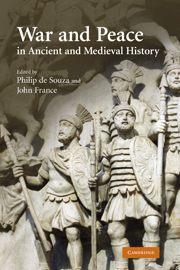Book contents
- Frontmatter
- Contents
- List of contributors
- Acknowledgements
- Note on abbreviations
- 1 Introduction
- 2 Making and breaking treaties in the Greek world
- 3 War, peace and diplomacy in Graeco-Persian relations from the sixth to the fourth century bc
- 4 Treaties, allies and the Roman conquest of Italy
- 5 Parta victoriis pax: Roman emperors as peacemakers
- 6 Treaty-making in Late Antiquity
- 7 Byzantine diplomacy: good faith, trust and co-operation in international relations in Late Antiquity
- 8 Treaties between Byzantium and the Islamic world
- 9 Siege conventions in Western Europe and the Latin East
- 10 Paying the Danegeld: Anglo-Saxon peacemaking with vikings
- 11 Peace among equals: war and treaties in twelfth-century Europe
- Bibliography
- Index
7 - Byzantine diplomacy: good faith, trust and co-operation in international relations in Late Antiquity
Published online by Cambridge University Press: 09 August 2009
- Frontmatter
- Contents
- List of contributors
- Acknowledgements
- Note on abbreviations
- 1 Introduction
- 2 Making and breaking treaties in the Greek world
- 3 War, peace and diplomacy in Graeco-Persian relations from the sixth to the fourth century bc
- 4 Treaties, allies and the Roman conquest of Italy
- 5 Parta victoriis pax: Roman emperors as peacemakers
- 6 Treaty-making in Late Antiquity
- 7 Byzantine diplomacy: good faith, trust and co-operation in international relations in Late Antiquity
- 8 Treaties between Byzantium and the Islamic world
- 9 Siege conventions in Western Europe and the Latin East
- 10 Paying the Danegeld: Anglo-Saxon peacemaking with vikings
- 11 Peace among equals: war and treaties in twelfth-century Europe
- Bibliography
- Index
Summary
In 555 the Roman commander in Lazica, Martin, summoned the Laz king Gobazes II to a conference, ostensibly to discuss an attack on the Persian-held fort of Onoguris but in reality to carry out a carefully prepared plan to murder him (Agathias, Histories 3.2.9–3.4.6); relations had been strained for some time, and Martin and his collaborator Rusticus feared that Gobazes had been sending hostile reports about them to Justinian. The murderers had attempted in advance to secure imperial acquiescence by sending Rusticus' brother John to Constantinople, where, although he had failed to convince Justinian that Gobazes was a traitor, he induced the emperor to summon the king to his presence and to concede that he might be killed if he resisted (Agathias 3.3.2–6). So far the incident appears as a successful example of Roman ‘dirty tricks’, with the Romans actually managing to get their man, but the dénouement is more complex. The Laz contemplated switching their allegiance to the Persians, and, even if Agathias' presentation of a formal debate (3.8.4–3.14.1) is a historiographical convention, there is no reason to doubt that some leading Laz would have been keen to reactivate their links with Persia. Justinian's response was to instruct the senator Athanasius to investigate the matter thoroughly, in accordance with Roman law; John and Rusticus were arrested, subjected to a public trial when a break in hostilities permitted, condemned and executed after being paraded through the streets of Apsarus (Agathias 3.14.4–6; 4.1.1–4.11.4).
- Type
- Chapter
- Information
- War and Peace in Ancient and Medieval History , pp. 120 - 140Publisher: Cambridge University PressPrint publication year: 2008
- 19
- Cited by



